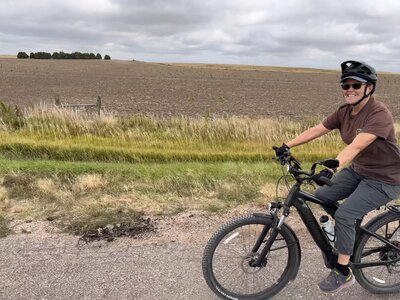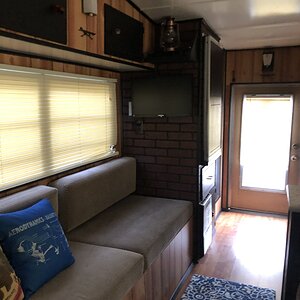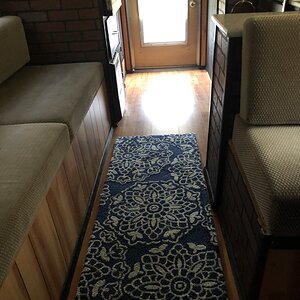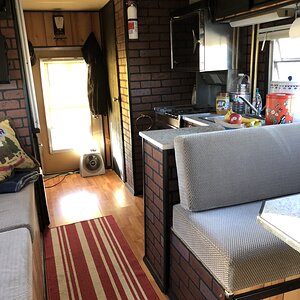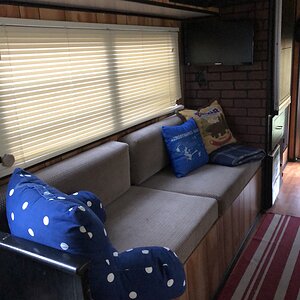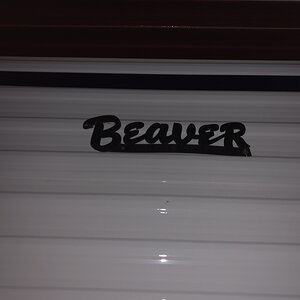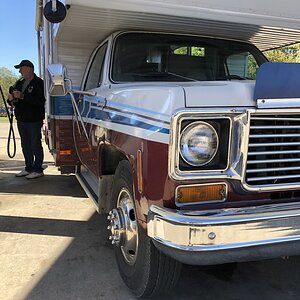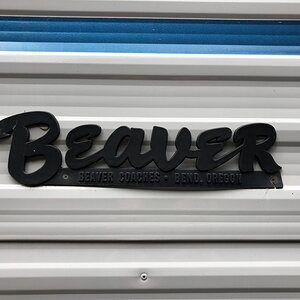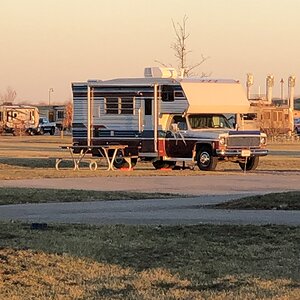- Joined
- Jan 19, 2021
- Messages
- 3,485
- Location
- Rosemary Farm
- RV Model
- Between RVs
- TOW/TOAD
- Toadless
- Fulltimer
- No
Experiencing lower than normal boost (about 25% below normal) I was grasping at straws looking (hoping) for a simple, cheap fix. I didn’t really think it was the fuel filters (only 2300 miles on them) but I had spares on board and it was a possibility, and being a cheap and easy rule-out I gave it a try. Naturally no improvement from that but of course I pushed on anyway. Other than long grades and initial acceleration the thing ran fine and I was able to easily ramble along at 65mph.
Until the grade headed east out of Cheyenne. That was a long pull at the top of which I had a flashing amber check engine light, immediately followed by solid amber, solid red, and complete and sudden shut down, all within about 30 seconds, barely giving me time to get to the shoulder and stop, and all the while temp and oil pressure gauges reading normal. So after sitting less than a minute, baffled, I decided I had to re-start the engine to avoid hot engine shut down issues and it started right up. I put it in gear and it ran although obviously severely derated. Fortunately we were at an exit, with a small truck parking area on the side of the accompanying on ramp.
I parked, kept it running, and plugged in my trusty Diesel Handheld code reader and found SPN 5862 FMI 9 - Aftertreatment 1 SCR Intermediate Gas Temperature - Data Valid but Above Normal Operating Range. There is lot of info on this including three “possible“ causes in the library, none of which were correct. I’ll paste in the long version at the end of this post for anyone interested. The only other code was SPN 110, FMI 31 - Engine Coolant Temperature - Data Valid but Above Normal Operating Range. This seemed to be a result of the shut down as my temp gauge read normal before, and also normal immediately after re-starting, but was pegged momentarily while the engine was stopped - the reason I immediately restarted it. Interestingly this code also seems to be a clue to the actual issue (high exhaust temp) - more on that below as well.
I cleared the codes (there was no code indicating de-rate or anything else - just the two codes above) and we decided to move on down the road driving it as easy as possible since all indications at that point were that it was operating normally - no overheat, no recurring codes, etc. This seemed to be just another spurious mystery emissions glitch, similar to what many others have experienced. We stopped that night at the Cabela‘s campground in Sidney NE, everything still seeming normal. But the next morning we had a loud, screeching exhaust leak, apparently opening up after everything cooled. It was exactly one mile to Floyd’s Truck Service (we saw the Freightliner sign on the way in to the CG) so we drove straight there and are still here four days later and will apparently be here most of next week.
The Cause:
The apparent culprit is a leaking CAC causing the low boost I was experiencing, which I found inconvenient but unfortunately didn’t recognize it as a condition that could lead to bigger issues. The bigger issue is that it led to a rich fuel/air ratio because the engine was getting less air than it should but the ECM was still feeding it full fuel, which was everything it could since I was climbing a grade under load. The result was a very high exhaust temp even though the engine temp was normal. This warped the exhaust manifold beyond any point of re-surfacing, and of course I need a new CAC.
The only other pertinent info is that I had to do a forced regen early in the trip and that seemed like it was too soon since the last one, and later caught the system in the act of several active regens. This seemed weird but I chalked it up to a needy emissions system. The actual reason was excessive soot due to the rich fuel mix, but of course I never made this connection early on, just like I dismissed the low boost as troubling but not significantly consequential. Live and learn…
So I called Nappanee, cancelled my week at Camp Newmar, which was the reason for this trip, cancelled a bunch of other plans, boarded the dogs locally and we are currently holed up in a Comfort In owned by the Love‘s next door and across the street from Floyd’s. We have the Jeep and the bikes and are trying to make the best of it while we wait for parts. The shop is very professional, capable, and accommodating and provided a lot of info on fun and exciting things to do when stuck in Sidney Ne. What fun!
The Codes:
Fault Code: SPN 5862 FMI 16 (4525)
SPN: 5862
FMI: 16
Aftertreatment 1 SCR Intermediate Gas Temperature - Data Valid but Above Normal Operating Range - Moderately Severe Level
Reason:
High SCR Intermediate temperature detected.
Circuit Description:
The aftertreatment SCR (selective catalytic reduction) temperature sensor module is a smart device that communicates with the engine control module via the J1939 data link. The aftertreatment SCR temperature sensor module performs its own internal diagnostics and reports malfunctions back to the engine control module using the J1939 data link.
The aftertreatment SCR temperature sensor module is used to measure the aftertreatment SCR intermediate temperature and aftertreatment SCR outlet temperature. The temperature probes are permanently attached to the aftertreatment SCR temperature sensor module and can NOT be replaced individually.
The Engine Control Module (ECM) detected the aftertreatment SCR intermediate temperature was above 650°C [1202°F] for 60 seconds.
1. The ECM illuminates the red STOP ENGINE lamp immediately after the diagnostic runs and fails.
2. The engine will be shut down if the Engine Protection Shutdown feature is enabled.
3. Progressive power and/or speed derate increasing in severity from time of alert.
4. If the Engine Protection Shutdown feature is enabled, the engine will shut down 30 seconds after the red STOP lamp starts flashing.
The aftertreatment SCR temperature sensor module is mounted on the aftertreatment SCR catalyst.
1. To validate the repair, perform a key cycle, start the engine and let it idle for 1 minute.
2. The fault code status displayed by the diagnostic tool will change to INACTIVE immediately after the diagnostic runs and passes.
3. The ECM will turn off the red STOP ENGINE lamp immediately after the diagnostic runs and passes.
4. The Reset All Faults command in the diagnostic tool can be used to clear active and inactive faults, as well as extinguish the MIL for OBD applications.
This diagnostic runs continuously when the engine is running and active regeneration of the aftertreatment diesel particulate filter is not occurring.
Possible Causes of this Fault Code Include:
1. Malfunctioning fuel injectors
2. Malfunctioning aftertreatment SCR intermediate temperature sensor
3. Contaminated diesel exhaust fluid
Fault Code: SPN 110 FMI 31 (2646)
SPN: 110
FMI: 31
Engine Coolant Temperature - Condition Exists
Reason:
The EGR valve was closed to reduce engine coolant temperature.
Circuit Description:
The coolant temperature sensor is a variable resistor sensor and is used to measure the temperature of the coolant of the engine. The engine control module (ECM) supplies 5 volts to the coolant temperature signal circuit. The ECM monitors the change in voltage caused by changes in the resistance of the sensor to determine the coolant temperature.
The Engine Control Module (ECM) detected the engine coolant temperature was above a threshold and closed the EGR valve to reduce the engine coolant temperature.
1. The ECM illuminates the amber CHECK ENGINE lamp immediately when the diagnostic runs and fails.
2. Exhaust Gas Recirculation (EGR) valve operation will be disabled.
3. Engine torque will be reduced if the engine is operated for an extended period of time with this fault active.
4. Possible reduced engine performance.
The engine coolant temperature sensor is located on the thermostat housing.
1. To validate the repair, perform a key cycle, and leave the key in the ON position for 1 minute.
2. The fault code status displayed by the diagnostic tool will change to INACTIVE immediately after the diagnostic runs and passes.
3. The ECM will turn off the amber CHECK ENGINE lamp immediately after the diagnostic runs and passes.
4. The Reset All Faults command in the diagnostic tool can be used to clear active and inactive faults, as well as extinguish the MIL for OBD applications.
This diagnostic runs continuously when the engine is running.
When the engine coolant temperature nears the engine protection limits, the EGR valve will be closed to reduce the coolant temperature. This fault code is used as an information fault code, ONLY indicating that the EGR valve has closed. No malfunction has occurred to cause this fault code. Other engine protection fault codes will be active if the engine coolant temperature has exceeded the engine protection limits.
Until the grade headed east out of Cheyenne. That was a long pull at the top of which I had a flashing amber check engine light, immediately followed by solid amber, solid red, and complete and sudden shut down, all within about 30 seconds, barely giving me time to get to the shoulder and stop, and all the while temp and oil pressure gauges reading normal. So after sitting less than a minute, baffled, I decided I had to re-start the engine to avoid hot engine shut down issues and it started right up. I put it in gear and it ran although obviously severely derated. Fortunately we were at an exit, with a small truck parking area on the side of the accompanying on ramp.
I parked, kept it running, and plugged in my trusty Diesel Handheld code reader and found SPN 5862 FMI 9 - Aftertreatment 1 SCR Intermediate Gas Temperature - Data Valid but Above Normal Operating Range. There is lot of info on this including three “possible“ causes in the library, none of which were correct. I’ll paste in the long version at the end of this post for anyone interested. The only other code was SPN 110, FMI 31 - Engine Coolant Temperature - Data Valid but Above Normal Operating Range. This seemed to be a result of the shut down as my temp gauge read normal before, and also normal immediately after re-starting, but was pegged momentarily while the engine was stopped - the reason I immediately restarted it. Interestingly this code also seems to be a clue to the actual issue (high exhaust temp) - more on that below as well.
I cleared the codes (there was no code indicating de-rate or anything else - just the two codes above) and we decided to move on down the road driving it as easy as possible since all indications at that point were that it was operating normally - no overheat, no recurring codes, etc. This seemed to be just another spurious mystery emissions glitch, similar to what many others have experienced. We stopped that night at the Cabela‘s campground in Sidney NE, everything still seeming normal. But the next morning we had a loud, screeching exhaust leak, apparently opening up after everything cooled. It was exactly one mile to Floyd’s Truck Service (we saw the Freightliner sign on the way in to the CG) so we drove straight there and are still here four days later and will apparently be here most of next week.
The Cause:
The apparent culprit is a leaking CAC causing the low boost I was experiencing, which I found inconvenient but unfortunately didn’t recognize it as a condition that could lead to bigger issues. The bigger issue is that it led to a rich fuel/air ratio because the engine was getting less air than it should but the ECM was still feeding it full fuel, which was everything it could since I was climbing a grade under load. The result was a very high exhaust temp even though the engine temp was normal. This warped the exhaust manifold beyond any point of re-surfacing, and of course I need a new CAC.
The only other pertinent info is that I had to do a forced regen early in the trip and that seemed like it was too soon since the last one, and later caught the system in the act of several active regens. This seemed weird but I chalked it up to a needy emissions system. The actual reason was excessive soot due to the rich fuel mix, but of course I never made this connection early on, just like I dismissed the low boost as troubling but not significantly consequential. Live and learn…
So I called Nappanee, cancelled my week at Camp Newmar, which was the reason for this trip, cancelled a bunch of other plans, boarded the dogs locally and we are currently holed up in a Comfort In owned by the Love‘s next door and across the street from Floyd’s. We have the Jeep and the bikes and are trying to make the best of it while we wait for parts. The shop is very professional, capable, and accommodating and provided a lot of info on fun and exciting things to do when stuck in Sidney Ne. What fun!
The Codes:
Fault Code: SPN 5862 FMI 16 (4525)
SPN: 5862
FMI: 16
Aftertreatment 1 SCR Intermediate Gas Temperature - Data Valid but Above Normal Operating Range - Moderately Severe Level
Reason:
High SCR Intermediate temperature detected.
Circuit Description:
The aftertreatment SCR (selective catalytic reduction) temperature sensor module is a smart device that communicates with the engine control module via the J1939 data link. The aftertreatment SCR temperature sensor module performs its own internal diagnostics and reports malfunctions back to the engine control module using the J1939 data link.
The aftertreatment SCR temperature sensor module is used to measure the aftertreatment SCR intermediate temperature and aftertreatment SCR outlet temperature. The temperature probes are permanently attached to the aftertreatment SCR temperature sensor module and can NOT be replaced individually.
The Engine Control Module (ECM) detected the aftertreatment SCR intermediate temperature was above 650°C [1202°F] for 60 seconds.
1. The ECM illuminates the red STOP ENGINE lamp immediately after the diagnostic runs and fails.
2. The engine will be shut down if the Engine Protection Shutdown feature is enabled.
3. Progressive power and/or speed derate increasing in severity from time of alert.
4. If the Engine Protection Shutdown feature is enabled, the engine will shut down 30 seconds after the red STOP lamp starts flashing.
The aftertreatment SCR temperature sensor module is mounted on the aftertreatment SCR catalyst.
1. To validate the repair, perform a key cycle, start the engine and let it idle for 1 minute.
2. The fault code status displayed by the diagnostic tool will change to INACTIVE immediately after the diagnostic runs and passes.
3. The ECM will turn off the red STOP ENGINE lamp immediately after the diagnostic runs and passes.
4. The Reset All Faults command in the diagnostic tool can be used to clear active and inactive faults, as well as extinguish the MIL for OBD applications.
This diagnostic runs continuously when the engine is running and active regeneration of the aftertreatment diesel particulate filter is not occurring.
Possible Causes of this Fault Code Include:
1. Malfunctioning fuel injectors
2. Malfunctioning aftertreatment SCR intermediate temperature sensor
3. Contaminated diesel exhaust fluid
Fault Code: SPN 110 FMI 31 (2646)
SPN: 110
FMI: 31
Engine Coolant Temperature - Condition Exists
Reason:
The EGR valve was closed to reduce engine coolant temperature.
Circuit Description:
The coolant temperature sensor is a variable resistor sensor and is used to measure the temperature of the coolant of the engine. The engine control module (ECM) supplies 5 volts to the coolant temperature signal circuit. The ECM monitors the change in voltage caused by changes in the resistance of the sensor to determine the coolant temperature.
The Engine Control Module (ECM) detected the engine coolant temperature was above a threshold and closed the EGR valve to reduce the engine coolant temperature.
1. The ECM illuminates the amber CHECK ENGINE lamp immediately when the diagnostic runs and fails.
2. Exhaust Gas Recirculation (EGR) valve operation will be disabled.
3. Engine torque will be reduced if the engine is operated for an extended period of time with this fault active.
4. Possible reduced engine performance.
The engine coolant temperature sensor is located on the thermostat housing.
1. To validate the repair, perform a key cycle, and leave the key in the ON position for 1 minute.
2. The fault code status displayed by the diagnostic tool will change to INACTIVE immediately after the diagnostic runs and passes.
3. The ECM will turn off the amber CHECK ENGINE lamp immediately after the diagnostic runs and passes.
4. The Reset All Faults command in the diagnostic tool can be used to clear active and inactive faults, as well as extinguish the MIL for OBD applications.
This diagnostic runs continuously when the engine is running.
When the engine coolant temperature nears the engine protection limits, the EGR valve will be closed to reduce the coolant temperature. This fault code is used as an information fault code, ONLY indicating that the EGR valve has closed. No malfunction has occurred to cause this fault code. Other engine protection fault codes will be active if the engine coolant temperature has exceeded the engine protection limits.
Last edited:

